The last leg
We left the all too familiar surroundings of Gümüşgün just after 1pm, bound once again for Karakuyu (our third visit during the tour).
On this occasion we were following a freight train rather than delaying one. At our next stop, Keçiborlu, we had to wait twenty minutes for the freight train ahead of us to reach Karakuyu and clear the section before we could proceed. The stop provided a good opportunity to wander and explore the surroundings of the station. It wasn’t too long before some local lads turned up to watch our steam locomotive, albeit being dragged backwards by a diesel!
On the run to Karakuyu we had the opportunity to try a few runpasts with some trees offering a wonderful display of autumnal gold, though the morning’s blue skies and guarantee of sun were now long gone. The sun co-operated just long enough to give us the shots we wanted and we re-boarded for the run through to Karakuyu, passing the wildly overgrown remains of Capali at 2.42pm, before reaching our destination ten minutes later.
The weather was clearly on the turn now, with black clouds in the distance threatening much worse conditions. We spent barely half an hour at Karakuyu, noting the presence of DE 36 005 dropping ballast, before heading back. In the short time we had spent in the station our diesel had been re-positioned to the middle of the consist which must have looked rather odd to any onlooker but suited our needs.
At 3.45pm we stopped at a rural location complete with concrete irrigation canals and beautifully sunlit trees against a rapidly darkening sky. The rain was almost upon us, but we just managed to squeak the runpast in with the very last of the sun’s rays after some particularly speedy work by our tour organiser.
Much credit needs to go to the crew for this shot – it had been the plan to hold a barbeque at Karakuyu but they had been reluctantly persuaded to carry on a little longer whilst we still had the sun, despite their initial pleas that they were so hungry that they couldn’t work any more. Thank you all for delivering a superb photographic opportunity!
We reached the notorious 401km marker (the scene of yesterday’s long picnic) at 4pm, with the rain just moments away. It turned out to be the perfect spot for another firebox barbeque and we were pleased not to be on the lineside when the rain started hammering down. After an hour at this location we set off again on our return journey to Isparta.
On the return journey the remaining stations were reeled off in quick succession with only brief stops at Bozanonu and the hillside just beyond to delay us. By this point the tour felt like it was on its last legs with just eight photographers left from the original party to clamber out for a last runpast (our one day trippers were sensibly settled inside the carriage and weren’t about to move for a photo in the fading light). We finally made it back into Isparta at 6.48pm.
Our arrival at Isparta signalled the end of my travels by steam through Turkey. I made some hurried farewells and jumped in a taxi for the short drive across town to the Otogar (coach station). My hopes for a speedy departure to Antalya were soon dashed – the next coach was not due to leave until 8pm, giving me an hour to grab some food and kill time looking around the astonishing number of rose-product shops around the terminal.
The domestic transport networks of Turkey are quite fascinating and unlike anything I have seen anywhere else – frequent connections can be made across the country by coach and plane, depending on whether speed us of the essence. It is not difficult to see why it has been difficult for Turkish Railways to compete with their current set up, but with high speed rail there is the chance of carving out a market. It remains to be seen what effect this will have on the rather excellent domestic transport options and the existing sleeper trains in the country, both of which make this an easy country to get around.
The journey south to Antalya took two hours and fifteen minutes, followed by a short tram ride from the Otogar to the old town. I checked in to my hotel at 11pm and collapsed in my ridiculously over-sized room. Time to sleep well!
Gallery
Steam on the Isparta branch
It was not without a little trepidation that I wheeled my suitcase down to the station in Isparta this morning, but I needn’t have worried – our steam locomotive was in the platform looking resplendent in the morning light. Better still, the air pump was working!
A little chat before the start of the day’s adventures gave us the explanation for this impressive change. It transpired that the two air pumps were not identical, so the exchange in Dinar had not been quite as straightforward as had been expected. The replacement from Uşak needed some extra work when we made it to Isparta but was working properly late last night. I was comforted by this reassuring news, which I hoped would put us in good stead for the day ahead of us.
As this was an extra day, after the official end of the tour, the numbers of photographers had thinned rather dramatically. However, one of our fellow photographers had brought a coach full of friends so we didn’t find ourselves rattling around empty coaches for very long.
At 8.25am we set off up the branch line hauled by our trusty diesel. At the appropriate spots the diesel and service car were detatched for runpasts. The branch may only be 13km long but it certainly packs in some wonderful scenery, which we tried to capture as best we could – from the fields, hillsides and atop rock cuttings. We were not alone in this endeavour – a photographer in a microlight could be seen buzzing above our position, before heading away with a friendly wave. It was one of those occasions where everything came together – steam locomotive, scenery and sun!
One of the guys on the tour reminded us that when a regular train passes it is nothing, but when a steam train passes it is a happening. It certainly seemed true today – no one could take their eyes of this majestic locomotive, whether it be the teenagers on the platform or the fruit pickers in the fields. Mind you, the branch has been closed to passenger traffic for some years, so any passenger train would have been somewhat unusual!
The Isparta branch was originally constructed in the mid-1930s and whilst it is closed to passenger traffic now there are plans to reconnect the city to the rail network with the contruction of a new high speed line from Afyon to Antalya. The contrast was striking, particularly as we reached the former junction station of Bozanönü and the now closed line to Egirdir (the track is still there for now, albeit grassed over).
Our short run from the junction brought us back to Göltaş and on to Gumusgun, which we reached at 12.43pm. At this point six photographers hopped out, having arranged for a dolmus to pick them up here. This was probably the sensible option but I figured that as I had gotten so far that I might as well see it through to the end, hoping that this wasn’t a very foolish move!
Gallery
For a few Dinars more
The scene that awaited us at Dinar station in the morning lifted our hearts – our kriegslok was sitting in the platform and seemed to be in much better health than when we left her. We were not alone in our appreciation for the locomotive, with quite a number of straggling schoolkids having made a detour on their way to school in order to get a selfie with the locomotive and the historic green carriages.
The town secured its place on the railway map of Anatolia in 1889, following the extension of the line operated by the Oriental Railway Company between Izmir and Aydin. The staff at Dinar are justifiably proud of their connection to railway history (the stretch between Izmir and Seydiköy was the first to open within the footprint of present-day Turkey) with many reminders of this illustrious history on display at the station (a plinthed steam locomotive from 1928, a model of a steam locomotive, a small railway museum and some historic remnants from the ORC on the platform). It seemed perfect to add a working steam locomotive to this picture, if only for a little while.
Dinar is not likely to be on any tourist itinerary, although its position on a major crossroads on the route to Antalya means that it is never short of traffic. It is sadly more likely to be remembered as the epicentre of an earthquake in October 1995 that killed 94 people and left many more injured or homeless. Our visit was too fleeting to appreciate the changes to the town since then, but our trip into the surrounding hills demonstrated the considerable natural beauty offered by the area.
After departing Dinar at 8.55am we made our way towards Karakuyu with just two carriages and a wagon, stopping frequently for runpasts. The scenery was quite superb throughout and delivered more opportunities than we could possibly take. The dilemma of which spot to choose was exacerbated by the limited time in each location, which was certainly a good thing – it seems that the more time you give some photographers, the more they doubt the position they have chosen, prompting a good impression of a headless chicken. I have been guilty of this in the past, but these days tend to stick to my spot for better or worse!
The last shots of the morning came from the tunnel mouth at the 388km mark, which included the unusual and entirely unexpected sight of a colony of bats emerging from the tunnel along with the locomotive.
Our train arrived at Karakuyu station at 12.18pm where we found DE36 002 dropping ballast for collection. After taking a ride around the loop we headed on to Isparta, stopping not long after Karakuyu for a runpast at a particularly delightful spot of marsh.
The next stop, just beyond Capali at the 401km point, was not so welcome. TCDD 56548 was once again beset by problems with the air pump. The diesel returned with the service car and the crew got to work, sadly to little reward from the recalcitrant pump.
The three hour stop gave us ample opportunity for a barbeque, with the meat cooked on a shovel in the firebox. I particularly liked the confidence and finesse with which salt was sprinkled on top, as if to say that this was the way any good chef would choose to cook if they could!
At 5.07pm we set off again, with diesel assistance, reaching Gümüşgün at 5.46pm. DE36 004 was waiting there with a freight, presumably held up by our unexpected stop. After this we contnued on to Goltas (6.12pm), with its vast cement works, the former junction station of Bozanonu (6.18pm) and finally Isparta (6.40pm). Our run in had given us a tantalising glimpse of the beauty of the branch line and left us all hoping that our loco could could deliver something special for our last day.
Gallery
Burdurm
The group assembled at 7.30am in readiness for an early departure, although some mischievous souls started running a book on when we would actually leave. Sadly, the joke was on us when even the wildest of the predictions turned out to be too early – the air pump was yet again proving to be problematic. Whilst we waited for news we settled down in the station’s Büfe, rather delightfully mis-translated as ‘sideboard’ on the english language signs!
One small compensation for our extended stay in Burdur was that we got to see a mini-diesel gala as the station-pilot got to work shunting container wagons in the yard.
The station pilot here, 18 108, is one of a handful of survivors from a small class of 20 diesel locomotives. To put some context on the numbers, these light-axle load locomotives were ordered at the same time (in 1968) as the class 24 diesels, of which some 418 were eventually built. The pilot had been well hidden amongst the lines of containers yesterday, but today it was busy at work shunting around the crane and loading point.
In the meantime the crew took the air pump apart, cleaned out all the gunge and re-assembled it. A former engineer in Izmir instructed the crew on everything they could do, but the air pump still failed to co-operate. Finally, it was agreed that an expert in air pumps would have to make the journey from the Usak museum depot (some 5-6 hours away) with the necessary spare parts. The hope is that they can get it working for the run tomorrow.
In any tour that relies on a single engine you are taking a risk, but it seemed like a good risk to take at the outset – this locomotive ought to be good for another ten years. In recent years she has received new wheels, a new firebox and a new boiler (from Meiningen) so it was disappointing that after all that the air pump let us down (the first time that anything like this has happened in the tours run here over the last seven years).
I had to remind myself that even a newbuild like Tornado had contended with similar problems – in April 2013 she suffered from a high profile failure of a new air pump whilst working a tour and had to be rescued by diesel (her second air pump had failed previously and was already awaiting repair). Maybe the problem on our trip will have a positive result if the museum depot acknowledges the need to overhaul a second locomotive.
At 2pm we were finally ready to leave with a plan for a few runpasts (albeit with the diesel atached to provide air pressure whilst the air pump was out of action) but then DE36 002 arrived with a freight, blocking the line out!
We eventually departed Burdur, under diesel power, at 3.55pm. In the run to Dinar we managed three runpasts. Although the set up for the runpasts was not the most ideal, it was still a pleasure to be back at the lineside taking photographs. There is only so much diesel excitement that anyone can take in Burdur yard…
Our train finally reached Dinar at 6.40pm and we made the short transfer to our hotel by minibus. Soon after we ate at one of the oddest restaurants of the trip – it was perfectly fine but opened out onto the forecourt of a petrol station, complete with the occasional waft of petrol fumes through the unshuttered sides! A strange end to a strange day – one that I suspect most of us are happy to say farewell to. I hope that tomorrow brings us better fortune.
Gallery
Whistle while you work
Our arrival in Burdur after dark gave us little chance to assess the opportunities of this short branch line but this was something that we intended to remedy today. The station itself was neat and tidy, despite the absence of passengers, with a plinthed loco standing on guard outside (57020).
The line no longer sees passenger traffic but that doesn’t mean that it is dead. On our return to the station it was clear that the railway line plays a significant part in the industrial operations here and this must have been a factor in the survival of the line up to now. In contrast, the nearby branch line to Eğirdir has closed despite the great efforts to capitalise on its vast tourist potential. Nevertheless, the writing must be on the wall for branch lines like this as Turkey’s railway modernisation project rolls out across the country.
After a little festival of shunting the composition of our train was altered to better reflect the sort of train that you might have expected to see on this branch in the 1970s/80s with the intention of taking three coaches and a single coal wagon up the branch line and on to Isparta. However, the plan was already unravelling…
The door to the engine shed had been altered since the last time our steam locomotive had visited Burdur and when it was backed into the shed the whistle was knocked off. Now, none of us had any great love for the ear-splitting whistel of 56548 but we couldn’t operate without the ability to sound a warning at the numerous crossings up and down the line.
The solution to this unexpected problem was right in front of us, as we soon began to appreciate with complete astonishment when a member of the crew clambered up onto the plinthed loco with a wrench. It was a noble sacrifice by 57020 to keep one of her brethen running! It is not the first time that 57020 has made such a donation – the same plinthed locomotive seems to have donated a buffer on a previous trip. Maybe if you come back in a decade, a few more donations on, you might find 56548 on the plinth and 57020 on the rails…
The repairs and adjustments were finally completed by 11am. I had not appreciated just how pleased I would be to hear the ear-splitting sound of a Turkish steam whistle again, but it was a joyous and painful moment all at once! We departed Burdur at 11.06am, just two and a half hours later than planned, and began our run up the line. The locomotive ran tender-first, which was not untypical of the operation here in steam days. After a couple of run pasts we reached Gümüşgün at 12.18pm.
At Gümüşgün the crew quickly demonstrated that Burdur had alot to learn about shunting festivals, proceeding to shunt the wagon and carriages one by one! Standing on the sidelines it was hard to work out quite what was going on, but it eventually transpired that we were either waiting for a freight to pass us – or that it was waiting two stops down the line for us to pass it. Mexican stand off anyone?
Thankfully, it was a beautiful day to laze around – albeit reluctantly! At 2pm DE36 002 arrived with a westbound freight train, passing a couple of derailed container wagons, followed half an hour later by a Burdur-bound freight in the hands of DE36 005. Yet, still we didn’t move – there was clearly more to this stop than just a case of supremely polite train pathing.
It soon became apparent that the cause of our lengthy stop was an erratic air pump which the crew were trying to fix with spare parts from the service car. The work was successfully completed by 3.30pm, but in the meantime we attended a hastily re-located surprise birthday party for a 70 year old railway engineer. It was a delightful occasion that only the most flint-hearted soul could have failed to be warmed by.
As we no longer had sufficient time to reach Isparta a new plan was hatched – we would head back to Burdur and try some run pasts on the branch line. This proved to be a good call as it delivered up some wonderful opportunities for sunset shots and allowed me to make a couple of attempts at contre-jour shots from the opposite side of the track. In spite of the frustations from earlier in the day, it was a truly glorious final hour.
Funnily enough, we were still just about in sight of Gümüşgün when the sun finally dipped below the mountains, but as another photographer remarked, it’s not the distance you travel but the work that you deliver in that time which counts. Never has a truer word been spoken.
Gallery
Steaming beyond Sandikli
After spending a little time at Tinaztepe we set off on our journey south, passing through Kocatepe (1.18pm) and Cigiltepe (1.30pm) before making it to Sandikli (2pm) where we took a late lunch stop. It was impressive to see a working water column here, given that in so many countries the infrastructure from steam days has rusted away or been removed long ago.
The news of the arrival of Turkey’s only working steam locomotive soon attracted the attention of the local kids and a couple of gentlemen from the media, who gathered a few reluctant photographers (including me) to pose awkwardly for a shot to be used in a story for their paper. Who could have anticipated that my 15 minutes of fame lay in the Afyon Gazette!?
Our stop at Sandikli also cleared the line for two freight trains that passed through in the direction of Afyon (the first just after our arrival and the second at 3pm precisely). The freights were notable for their use of GE PowerHaul PH37ACai diesel locomotives, a new class of locomotive which only began to roll off the production line relatively recently.
Tülomsas are building 20 locomotives of this type for Turkish Railways and another 30 for export (under a strategic partnership with General Electric). The first examples in Turkey had somewhat disappeared from view, so it was fascinating to see that they all had 70 (Afyon) allocations and are being used on this stretch of line. It makes much sense from a testing perspective as any failures here would have a low impact, given the light traffic we have seen.
After departing from Sandikli (3.47pm) we continued our journey south, passing through some stunning and quite deserted landscapes before reaching Ekinova (4.15pm) and the Karakuyu loop (5.05pm). The sun was about to drop below the hillside so the time for photography was rapidly running out. Nevertheless, we managed four runpasts on the loop before the light finally disappeared.
The spot for our runpasts, a rock cutting next to a quarry on the loop, looked stunning bathed in golden light but the location was not without its challenges, notably a strong wind which blew the smoke in all sorts of undesirable directions. On one of the runpasts the smoke even managed to mask the locomotive entirely to the grumbles of the assembled photographers! Nevertheless, I think we all managed to get something out of the location.
From the loop we made the short run into Karakuyu station at 5.40pm, where another DE36 hauled freight was waiting for us to clear the line (DE36004 this time). After a brief stop we began the final leg of our journey to Burdur at 6pm, passing through Capali (6.11pm), Keciborlu (6.32pm) and Gümüşgün (6.50pm) before reaching Burdur at 7.30pm.
Gallery
A cookery lesson at Tinaztepe
The train departed from Afyon at 9.09am precisely, retracing the steps we had taken last night as far as the junction to the west of the city. From this point, we took the line south and crossed over the top of a motorway. The whistles of our locomotive were soon matched by honking from lorries on the road below us, demonstrating once again the extraordinary reactions that a steam locomotive elicits here.
We reached the first station on the line, Tinaztepe, at 9.50am. In front of us we could see a small, but beautifully maintained station with a huge pile of sugar beet in the yard. At one time the steam hauled sugar beet trains drew railway enthusiasts and photographers out here in the autumn, but that is a scene long consigned to history.
One of the crew took a few of the sugar beet back to the train, clambered up onto the locomotive and placed them in the steam dome – the largest pressure cooker you will ever see! Needless to say, those of us looking up at the spectacle were simply astonished at this demonstration. It is a long way from the art of a fry up on the shovel, but quite fascinating to witness.
We left Tinaztepe behind just after 10am and spent the rest of the morning enjoying a series of runpasts on the line to Kocatepe, without ever getting as far as the next station. The conditions were decent enough, but improved in late morning with the re-appearance of the sun. It was certainly an interesting stretch of line with some great vantage points from the hillside. Once our morning’s work was done we rolled back down to Tinaztepe, arriving at 12.25pm. In the time we had been gone the farmer had sensibly collected his harvest, saving it from any more ravenous railwaymen roaming the area!
It was hard to avoid noticing how little rail traffic we had seen since arriving yesterday, despite this being a significant railway junction. Passenger traffic in the area seemed incredibly light, with just one railbus leaving Afyon in the hour or two we spent milling around before departing (a service to Eskişehir). Aside from this, the only other movement we saw was a double-headed diesel freight bound for the Syrian border.
Gallery
Steam to Afyon
An old gentleman wandered down the platform at Banaz, shaking the hand of everyone he came across, a broad grin on his face. This might seem odd under any other circumstance, but faced with a steam locomotive stirring into life, particularly the last one left working in the country, who is to say that isn’t the most natural response!? I, for one, never cease to tire of the sight.
After spending a little while hanging around the station, we began our day’s travel at 9.54am and reached our first stop, Oturak, at 10.24. The sun had broken through by this point and was beginning to deliver a beautiful morning, illuminating our locomotive and the autumnal backdrop wonderfully. It was one of those locations with so many delightful possibilities that our merry band of photographers were soon scrabbling around to get the very best out of the moment. I hope I did it some justice!
The next leg of our journey took us into the countryside around Dumlupinar, a place which holds special significance in Turkish history as it was here that the last, decisive, battle in the Greco-Turkish War (1919–1922) was fought. That victory, on August 30th 1922, is still celebrated as a national holiday to this day. The railway line was the main supply route of the Greek forces and one of the first actions of the Turkish cavalry was to cut this channel of communication. Today, the countryside is so peaceful that it is hard to imagine that so much blood was shed here.
We took our time here, with runpasts around the tunnel and at the summit, before making it to Dumlupinar station itself at 12.04pm. Although it feels like a relatively sleepy line, there are signs of substantial investment in the railways here with huge piles of sleepers and ballast. After getting permission to proceed, we departed at 12.27pm.
Our kriegslok might have be the last operative steam locomotive in Turkey, but it was certainly delivering everything we could have hoped for photographically with a storming run over the summit and a terrific impression of a volcano.
Our onward journey took us through Kizilcakoy (12.35pm) and on to Yildirim Kemal (12.47pm) where we had an extended stop and a series of four runpasts utilising the scenic station and water column. This must have made a bewildering sight for a couple of locals, who sat watching the madness of all this unfold from their viewpoint on the sidelines.
After leaving Yildirim Kemal at 1.50pm we were treated to a series of runpasts on a rather scenic stretch of track leading up to a grand curve. The last stop in the sequence offered the tempting combination of a flock of sheep in the foreground, but the sheepdogs had other ideas, shepherding the flock away from any viable shot. Nevertheless, the shepherd offered an irresistible alternative for some members of the group. It was one of those locations with an incredible array of possibilities and only one runpast to use them on. How to choose!?
The afternoon continued to offer some wonderful photographic opportunities, especially when the sun re-appeared to illuminate the autumn foliage. Our onward journey took us through Bal-Mahmoud (4.30pm) and then on to the outskirts of Afyon, where we made the most of the setting sun to capture the glint.
About twenty minutes after leaving this spot we reached Afyon station (6.12pm), having been treated to a distant view of the fortress rock on the way in. Our merry band of photographers clambered out of the vintage carriages and formed a suitcase wheeling convoy to a nearby hotel, ready for a welcome spot of rest and relaxation. It had been a good day’s work and very satisfying with it!
Gallery
Black clouds over Banaz
Our tour departed from Usak in late afternoon (around 3.30pm) after the final members of the party had arrived on the express from Izmir. The first leg of our tour was to take us a relatively short distance, from Usak to Banaz, in the hope of getting some good sunset shots.
It all started well enough with a couple of good stops in full sun, before the black clouds rolled in – bringing with them thunder and lightning. It would have been possible, with a bit of luck, to get lightning in the background of a shot though I certainly didn’t manage this. Nevertheless, we still managed four or five runpasts before the rain really kicked in at 5.15pm.
Needless to say, there was no glorious sunset to be photographed. If the resulting shots were far from stunning, it was nevertheless a good taster for the tour and got me in the right frame of mind for the photography that lay ahead. I have a habit of taking some really rubbish shots at the start of any tour, so I was relieved to have gotten my rusty moments out of the way!
Banaz station is not exactly a busy place during daylight – it sees just four passenger trains a day and all of these arrive between midnight and 4am! This left us plenty of time to play with for a night shoot, but first we sought out some food. A restaurant in town somehow managed to cope with an invasion of photographers and served up some pretty tasty lamb/cheese pide with a soft drink (a bargain at 15 Turkish lira apiece) before we returned.
I wasn’t feeling particularly inspired, so opted to sit this night shoot out and enjoyed the spectacle from a distance. Once the last shots had been fired we boarded a couple of buses for the short run back to Uşak, reaching our hotel at 10pm.
Autumn steam in West Turkey
Our tour through the autumnal landscapes of Western Turkey is due to begin in earnest today with a relatively short run from Uşak to Banaz. The tour will eventually take us on to Afyon, Dinar, Burdur and Isparta.
The motive power for the steam hauled elements of the trip will come from one of the thousands of class 52 kriegsloks, or war locomotives, that ended up across Europe during the second world war. Survivors can be found in many countries today, particularly in the East. I have already encountered members of the class in Bosnia, Serbia, Poland and Russia.
Our kriegslok, TCDD 56 548, was manufactured at Wiener Lokomotivfabrik Floridsdorf, near Vienna, in 1943. It was one of 43 classmates built for the Deutsche Reichsbahn which were initially loaned to Turkish Railways but later purchased outright.
During the tour 56 548 will haul an authentic passenger train formed of four refurbished green coaches (from the Usak Museum Depot) and a series of freight cars/wagons – it is a combination that wouldn’t have looked out of place in the 1970s or 80s. Indeed, TCDD 56 548 was active on the branch lines we will visit until 1989.
At the rear of the consist we will have a diesel locomotive which will be used to haul us through the longer distance stretches that we will need to cover during the tour. It is a sensible precaution, sparing us from the need to re-coal the steam locomotive en route. The diesel tasked with this job is DE 24 295, one of the 418 strong class that effectively replaced steam.
Uşak Depot Gallery
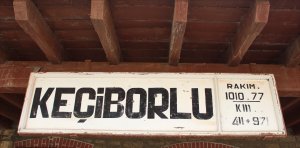
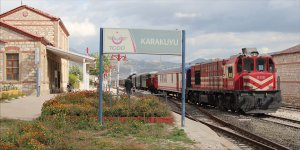





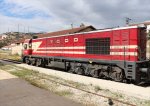







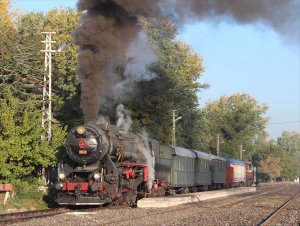
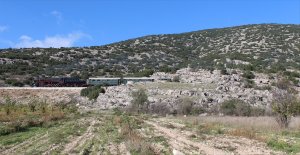
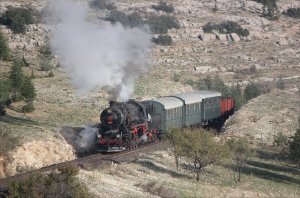




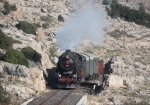
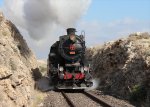


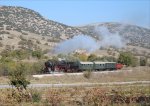





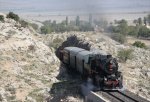

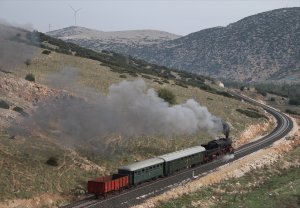
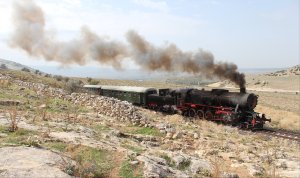
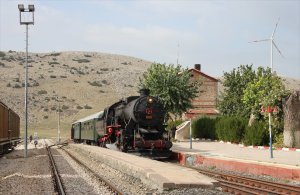
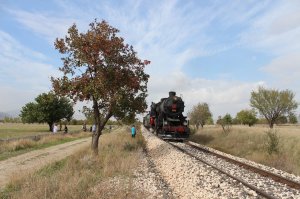

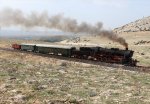















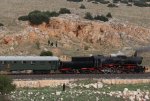





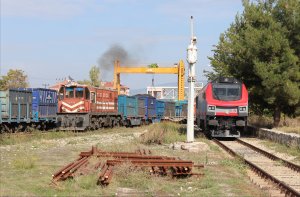

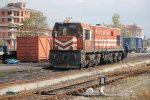
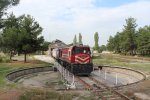


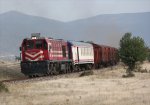


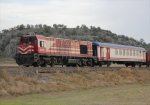

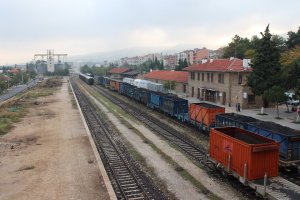
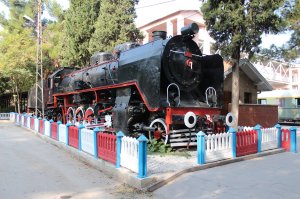

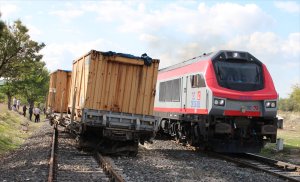
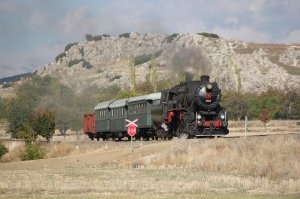
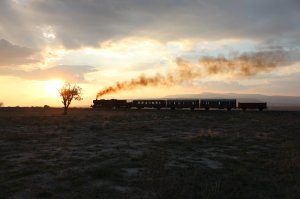





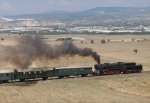

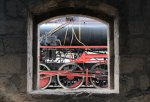
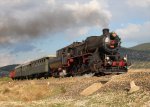
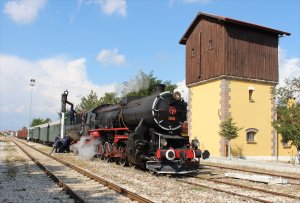
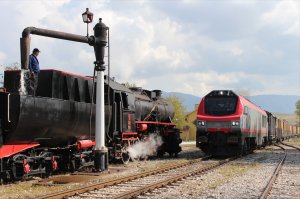
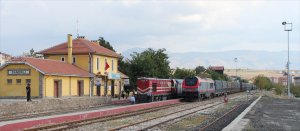
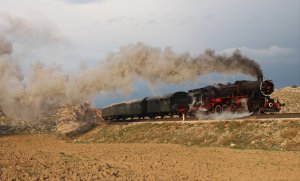





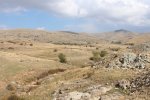



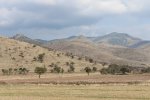
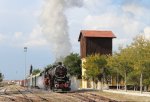


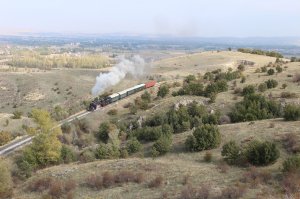




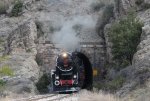
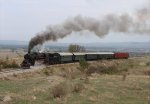
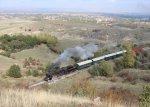
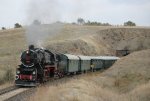

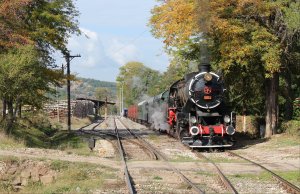
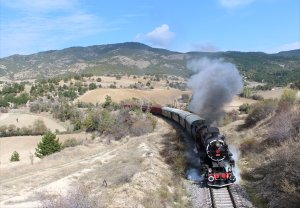
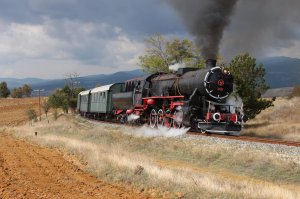
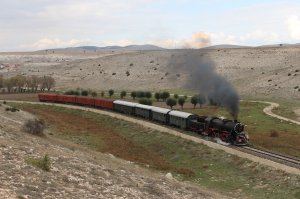

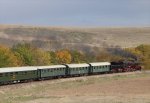
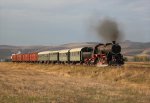


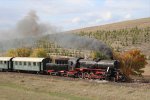


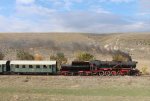
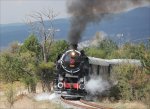

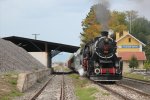
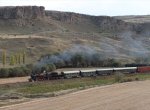


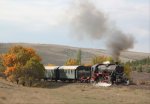
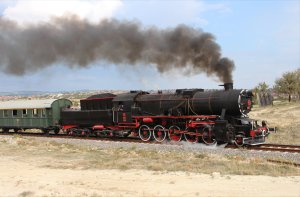
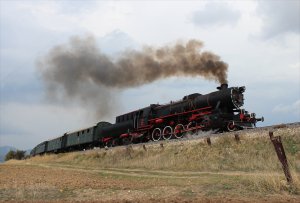
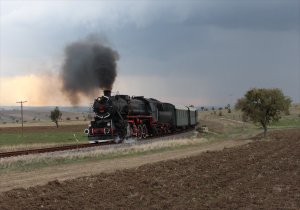
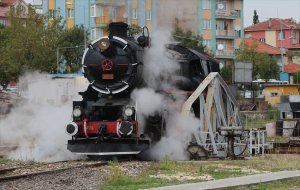
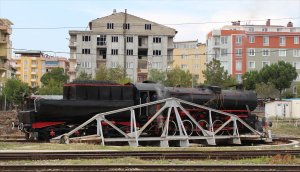
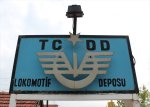




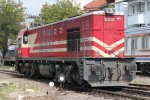
leave a comment